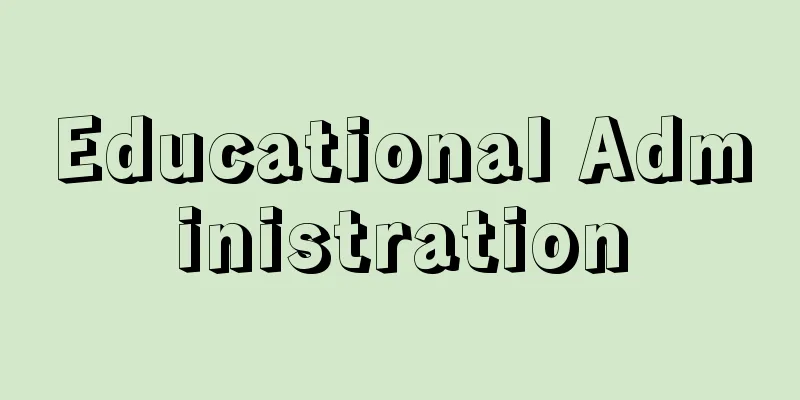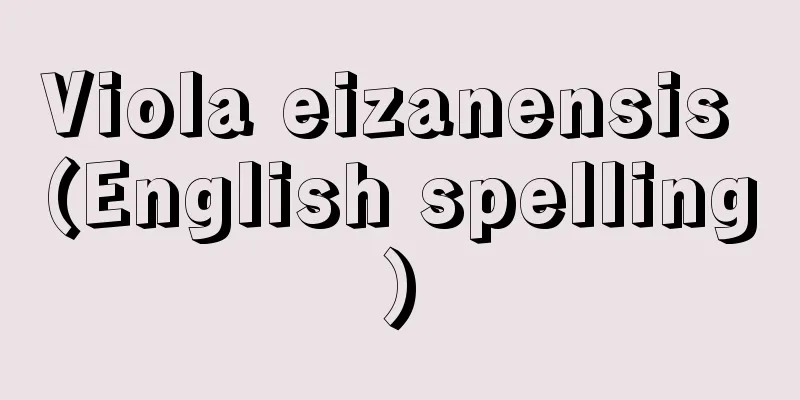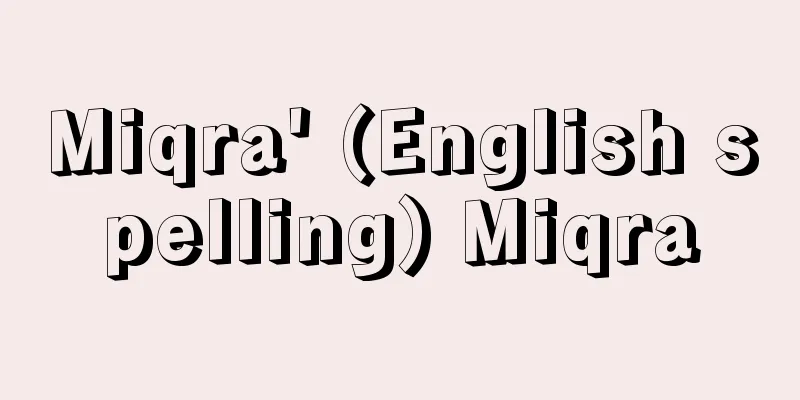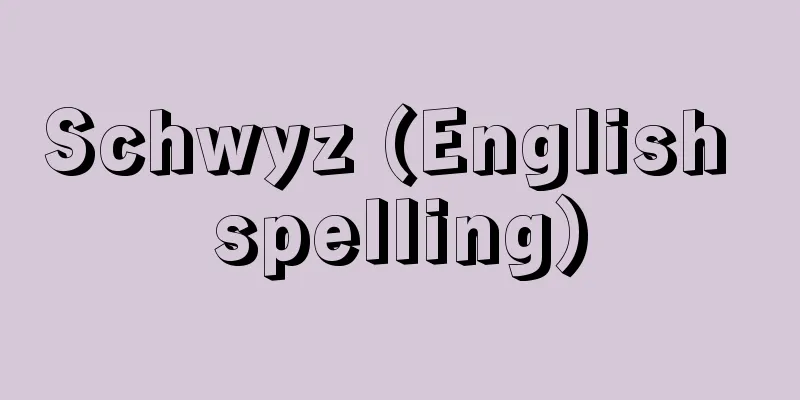Educational Administration

|
It refers to the administrative action of the national or local government in the public education system established by the country (state or province). Modern nations have made education an important concern, and have come to institutionalize a major part of it through their own legislative efforts. It is now developed to include not only school education but also social education, and not only public schools but also private schools. The operation of this modern public education system by the national or local government is educational administration. [Shintaro Iwashita] Basic IssuesThere, the fundamental factors being questioned are the nation's ideals and reality on the one hand, and the essence of education on the other, and the following are cited as basic issues for educational administration: (1) The relationship between the character, will, and authority of the state, which is the entity that forms the public education system, and the freedom of individual thought and belief (the issue of educational neutrality) [Shintaro Iwashita] Educational Administration Systems of Major CountriesIn educational administration, which faces the challenges mentioned above, the issue is how and to what extent the will of the people and the logic of education are incorporated into educational policy, which is the concrete expression of the nation's educational will, and into the educational system and educational administrative system that are the means of implementing it, that is, the issue of democracy and expertise in the educational system and administration. If we look at the educational administrative systems of other countries from this perspective, each country has created its own unique system, determined by its own historical and social conditions. [Shintaro Iwashita] AmericaThe educational administration system in the United States can be described as a school board system. Authority regarding education is entrusted to each state, and state, county, and city boards of education are the educational administrative bodies. These systems are based on the principles of decentralization of education, citizen authority and independence of education, and management centered on expert guidance and advice from specialized staff, and have created a system that reflects the will of residents in educational policy decisions and an operating structure centered on the superintendent and supervisor, who are educational experts. From the standpoint of democracy and expertise in educational administration, this can be said to be an excellent system. [Shintaro Iwashita] EnglandThe state does not directly regulate the school curriculum, and the only educational content stipulated by law is religious education. Decisions on the curriculum and the selection of textbooks are left to the principal and teachers. In this respect, the UK can be said to have created the most thorough educational administration system in terms of respect for educational expertise and school autonomy. [Shintaro Iwashita] FranceThe educational administration system is characterized by centralization, and the national government regulates even the most minute details of educational content. The educational administration units are the university districts and prefectures, and the university district rector is the highest authority in charge of unifying education from primary to higher education within the jurisdiction. He is selected from among university professors and acts on behalf of the Minister of Education. The prefectures have university district inspectors who act on behalf of the Minister of Education and university district rectors and are assisted by several elementary education inspectors. Not only are all of these educational administration officials educators or educational experts, but at each level of the educational administration structure (Ministry of Education, university districts, prefectures), advisory bodies composed of educational experts, mainly teachers, are established. In this way, the high level of expertise in educational administration is a distinctive feature of the French educational administration system, along with its centralization. [Shintaro Iwashita] GermanyIn Germany, internal matters of educational administration are handled by the state (province), and external matters are left to local governments, and supervision and guidance of internal matters are carried out by school inspectors, who are specialized educational officials of the state. Recently, the emphasis of the inspectors' duties has shifted from supervision and control to ensure that national (state) standards are met to cooperation and advice for teachers, and there is a movement toward the establishment of school committees with the participation of local governments, parents, teachers, and the general public. In other words, while the German educational administration system is based on centralization (at the state level) when it comes to internal matters, it has also adopted British expertise and American democracy. [Shintaro Iwashita] Japan's Educational Administration SystemThe central educational administrative agency is the Ministry of Education, Culture, Sports, Science and Technology, and the local educational administrative agency is the Board of Education. After the Second World War, based on the recommendations of the Report of the United States Education Mission, the Board of Education was established by the "Board of Education Law" promulgated in 1948 (Showa 23). The legal basis for the law was later revised in 1981 to the "Law Concerning the Organization and Management of Local Educational Administration." However, as a successor to the ideals of postwar educational administration, boards of education are established in all prefectures and municipalities (including some educational administrative associations and jointly established boards of education) nationwide. The principles of the Japanese Board of Education system are the same as those of the American Board of Education system (mentioned above), but the fundamental difference is that the Japanese Board of Education does not have the power to control education finances. In addition, issues facing the system include the fair reflection of public opinion, the appropriate size of the establishment unit, the qualifications of the superintendent and supervisor, and the improvement and development of the educational guidance system. [Shintaro Iwashita] Educational Administration Reform in Major CountriesIn 1984, the second Nakasone Yasuhiro cabinet set out education reform and established the Provisional Council for Education (Rinkyo-in), an advisory body directly under the Prime Minister. The reform principles were "emphasis on individuality," "transition to a lifelong learning system," and "responding to changes such as internationalization and the information age," and submitted four reports between 1985 and 1987. The Central Council for Education (Central Council for Education), an advisory body to the Minister of Education (now the Minister of Education, Culture, Sports, Science and Technology) established in 1953, also submits reports each time, promoting the establishment of a lifelong learning system, diversification of higher education, the enrichment and reform of primary and secondary education, and decentralization of educational administration. In the United States, under the Reagan administration in 1983, the National Council on American Excellence published a report titled A Nation at Risk, and in response to this, the Carnegie Forum on Education and the Economy submitted a report titled Prepared Nation, the 21st Century Teacher in 1986. Furthermore, in 1989, the G. H. W. Bush administration held the National Education Summit, which set a national goal of improving the deterioration of education and declining academic ability. This became a guideline for educational administration reform in each state. In the UK, major education reform began in 1985 under Prime Minister Thatcher, who was said to have been conscious of Japan's economic growth. Both reforms were based on a neoliberal stance, and were characterized by the fact that they were led by the central government and attempted to promote reforms based on the idea that market principles = liberalism. This principle was most evident in the reforms implemented by the Thatcher administration. Specifically, the powers of local education (administrative) authorities, who had been the guardians of "educational expertise and school autonomy," were restricted, particularly in the following areas: Among these, the problem with Japan's educational administration is that it is difficult to see the intention behind restricting whose authority and for what freedom. [Kimura Tsuneo] "Lectures on Educational Administration, edited by the Japanese Association of Educational Law, 6 volumes (1981, Kyodo Publishing)" ▽ "Principles of Educational Administration, by Ko Shido (1974, Daiichi Hoki Publishing)" ▽ "New Edition of Educational Administration, by Sagara Koichi (1979, Seibundo Shinkosha)" ▽ "Postwar Educational Reform in Japan 3: Educational Administration, by Suzuki Eiichi (1970, University of Tokyo Press)" ▽ "School Choice and School Participation: Learning from Experiments in American Educational Reform, by Kurosaki Isao (1994, University of Tokyo Press)" ▽ "Educational Participation and Democracy, by Onoda Masatoshi (1996, Kazama Shobo)" ▽ "Local Government Reform and Schools/Boards of Education, by Ogawa Masato (1998, Toyokan Publishing)" ▽ "Reform of the American Urban Board of Education System: Decentralization Policy and Educational Autonomy, by Tsuboi Yumi (1998, Keiso Shobo)" ▽ "Specialization of Urban Administration and Freedom of Participation and Choice" by Toshiyuki Omomo (2000, Kazama Shobo) [References] | | | | | | | | | |Source: Shogakukan Encyclopedia Nipponica About Encyclopedia Nipponica Information | Legend |
|
国(州、邦)によって制定された公教育制度における、国または地方公共団体による行政作用をいう。近代国家は教育を重要な関心事とし、その主要な部分を自らの立法的努力によって制度化するに至っている。いまや、それは学校教育だけでなく社会教育を、また、公立学校のみならず私立学校を含むものとして整備されている。この近代公教育制度の、国または地方公共団体による運営が教育行政である。 [岩下新太郎] 基本課題そこでは、一方において国家の理念やその現実、他方において教育の本質が基底的要因として問われることになり、次のことが教育行政の基本的課題としてあげられる。 (1)公教育制度形成の主体である国家の性格・意思・権限と個人の思想・信条の自由との関係(教育の中立性の問題) [岩下新太郎] 主要国の教育行政制度前述のような課題をもつ教育行政においては、国家の教育意思の具体的表現である教育政策、その実施方策としての教育制度・教育行政制度に、国民の意思と教育の論理がどのように、どの程度取り上げられているか、すなわち、教育制度・行政における民主性と専門性とが問題となる。この観点から諸外国の教育行政制度をみるならば、各国はそれぞれの歴史的社会的条件に規定されて独自のものをつくりあげている。 [岩下新太郎] アメリカアメリカ合衆国の教育行政制度は、教育委員会制度であるといえる。教育に関する権限は各州にゆだねられ、州やカウンティcounty、市などの教育委員会が教育行政機関である。それらは、教育の地方分権、教権在民、教権独立、専門職員による専門的指導助言を中心とする運営を理念とし、教育方針決定に住民の意思を反映する仕組みと教育専門家である教育長・指導主事を中心とする運営体制とをつくりあげている。教育行政の民主性、専門性という観点からは一つの優れた方式といえる。 [岩下新太郎] イギリス国は学校の教育課程を直接規制せず、教育内容について法律で規定されているのは宗教教育についてだけである。教育課程の決定や教科用図書の採択は校長や教員の手にゆだねられている。この点、イギリスは、教育の専門性と学校の自主性の尊重では、もっとも徹底した教育行政方式をつくりあげているといえる。 [岩下新太郎] フランス教育行政制度は中央集権を特色としており、教育内容についても国の規制が細部にまで及んでいる。教育行政単位は大学区・県からなっており、大学区長は管内の初等教育から高等教育までの最高の統一者で、大学教授から選任され文部大臣の職務を代行する。県には大学区視学官が置かれ、文部大臣・大学区長の職務を代行し、数人の初等教育視学によって補佐されている。これら教育行政担当官がいずれも教育者か教育専門家であるばかりでなく、教育行政機構の各段階(文部省、大学区、県)に教員を中心とする教育専門家によって構成された諮問機関が設置されている。このように、教育行政が高い専門性をもって運営されていることが、中央集権と並ぶフランス教育行政制度の特色である。 [岩下新太郎] ドイツ教育行政の内的事項は邦(州)で握り、外的事項は地方にゆだねる方式をとっており、内的事項に関する監督と指導とは、邦の教育専門職員である視学官によって行われた。最近は、視学官の任務の重点が国家(邦)的要求水準達成のための監督と統制から教員に対する協調と助言へと移り、地方公共団体・保護者・教員・一般人の参加による学校委員会設置への動きがみられる。すなわち、ドイツの教育行政制度は、内的事項については、中央集権(邦単位)を基本としながらも、イギリス的専門性、アメリカ的民主性を取り入れてきている。 [岩下新太郎] 日本の教育行政制度中央教育行政機関は文部科学省、地方教育行政機関は教育委員会である。教育委員会は、第二次世界大戦後、アメリカ教育使節団報告書の勧告に基づいて、1948年(昭和23)公布の「教育委員会法」によって発足し、その後56年に根拠法が「地方教育行政の組織及び運営に関する法律」と変わり改定されたが、戦後教育行政の理念を受け継ぐものとして、全国すべての都道府県、市町村(一部教育事務組合、共同設置教育委員会を含む)に設置されている。 わが国の教育委員会制度が掲げる理念は、アメリカの教育委員会制度と同じ(前述)であるが、それと基本的に異なる点は教育財政権をもたないことである。また、公正な民意の反映、設置単位の適正規模、教育長・指導主事の資格、教育指導体制の充実・整備などが制度上の課題となっている。 [岩下新太郎] 主要国の教育行政改革1984年(昭和59)第二次中曽根康弘(なかそねやすひろ)内閣は、教育改革を掲げ、総理大臣直属の諮問機関である臨時教育審議会(臨教審)を設置。「個性の重視」「生涯学習体系への移行」「国際化・情報化時代等の変化への対応」を改革の理念とし、85~87年に4次にわたる答申を提出した。また、1953年設立の文部大臣(現文部科学大臣)諮問機関である中央教育審議会(中教審)もそのつど答申を行い、生涯学習体制の整備、高等教育の多様化、初等・中等教育の充実と改革、教育行政の地方分権化などを推進している。 アメリカ合衆国では、1983年レーガン政権下で、「アメリカの優秀性(エクセレンス)に関する全米審議会」の報告書『危機に立つ国家』が出され、それに応えるものとして、86年教育と経済に関するカーネギー・フォーラム報告書『備えある国家、21世紀の教師』が提出された。さらに1989年G・H・W・ブッシュ政権は全米教育サミットを開催、教育荒廃・学力低下の改善を図って国家的目標を掲げた。このことは各州の教育行政改革の指針となった。 イギリスでは、日本の経済成長を意識したといわれるサッチャー首相のもと、1985年には教育の大改革が始まった。 いずれも新自由主義的立場にたった改革であり、中央政府の主導で、市場原理=自由主義という立場による改革を推進しようとした点が特徴的である。その原理は、サッチャー政権が行った改革にもっとも顕著である。具体的には、「教育の専門性と学校の自主性」の守護者であった地方教育(行政)当局の権限を、とくに以下の点、 これらのなかで、日本の教育行政の場合は、だれの、どのような自由のために、だれの権限を制限しようとしているのか、その意図がみえにくいという問題がある。 [木村力雄] 『日本教育法学会編『講座教育行政』全6巻(1981・協同出版)』▽『皇至道著『教育行政学原論』(1974・第一法規出版)』▽『相良惟一著『新版教育行政学』(1979・誠文堂新光社)』▽『鈴木英一著『戦後日本の教育改革3 教育行政』(1970・東京大学出版会)』▽『黒崎勲著『学校選択と学校参加――アメリカ教育改革の実験に学ぶ』(1994・東京大学出版会)』▽『小野田正利著『教育参加と民主制』(1996・風間書房)』▽『小川正人著『地方分権改革と学校・教育委員会』(1998・東洋館出版社)』▽『坪井由実著『アメリカ都市教育委員会制度の改革――分権化政策と教育自治』(1998・勁草書房)』▽『大桃敏行著『都市行政の専門化と参加・選択の自由』(2000・風間書房)』 [参照項目] | | | | | | | | | |出典 小学館 日本大百科全書(ニッポニカ)日本大百科全書(ニッポニカ)について 情報 | 凡例 |
<<: Educational planning - educational planning
>>: Fundamental Law of Education
Recommend
Emerald tree boa (English spelling)
Order Lacertilia, Family Pythonidae. A relatively ...
Guineafowl (Piper Hen) - Guineafowl (English spelling)
A species of bird in the family Guineafowl, or any...
Brockelmann, Carl
Born: September 17, 1868 in Rostock [Died] May 6, ...
Dixieland
...Eventually, brass band musicians were hired by...
First funeral - Ichijiso
...A burial method in which a body is temporarily...
Ethionamide
...For patients with smear-negative and no caviti...
Mount Hakone
A general term for the volcanic edifice that strad...
Crisis Denial - Hearing
…It is a system with the same purpose as Article ...
Song Lady - Song Lady
...However, the mass production of "recorded...
Puppetry - Ayatsurikyogen
1. A puppet show. 2. A form of puppet theatre adap...
Mount Rakan
A mountain on the border between Yamaguchi and Hi...
Kawayu [Hot spring] - Kawayu
This hot spring is a national health resort locate...
Goldenes Dachl (English spelling) GoldenesDachl
… Innsbruck, the state capital, faces the Inn Riv...
Kazari-Buddhist sculptor
...Also, around this time, artisans who painted B...
Big Newspapers and Small Newspapers - Oshinbunkoshinbun
There were two major types of newspapers in the ea...









